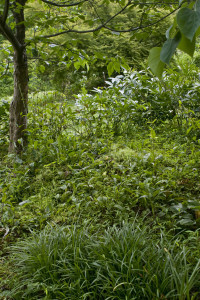Ann E. Michael's Blog, page 78
August 8, 2012
Amazon…
The second week of August is always a busy one for me. There’s little time for reflection–or writing.
I do have some news to impart, however: Water-Rites is now available on Amazon.com at this link. In the best interests of my publisher, Brick Road Press, I’m going to request that you order from the press itself if you can.


August 3, 2012
Fragments
The web journal qarrtsiluni is running an issue on “fragments.” I feel a bit fragmented myself lately. Here are a few recent, fragmentary thoughts.
~
I am reading Lewis Mumford’s tome The City in History and enjoying it for a number of reasons. One is Mumford’s ability to employ words such as “forfend” in a correct and even natural way. Another reason is the approach he takes to trying to reason through and tease out strains of pre-history that lead up to the establishment of cities world-wide, a kind of philosophical anthropology. Sixty years of subsequent archeological discovery and interpretation may alter his theories, or perhaps lean toward confirming them; I’m not enough of a scholar to know. I do, however, find his speculations appealing. One of his theories suggests that war developed along with hierarchical religion, kingship, and the city. It makes sense that militarization on any significant scale was not “invented” until there was population enough to support it and reasons (defend the king, the god, or the goods) to deploy a military body.
He does not say human beings are not inherently aggressive. He merely suggests that when we live in smaller, more isolated groups it is in our best interest to cooperate rather than to expend resources on warfare (soldiers, arms, defenses). Something to meditate upon in current times.
~
Mumford was researching and writing this book in the late 1950s (publication date was 1961). Interesting to me, he cites Jung’s archetypes and theories–though not in a way that implies Mumford was in any way a Jungian–about the feminine and the masculine as regards the development of human social structures. Bachelard, writing at about the same time, also cites Jung when he discusses the poetic space. I think of Bachelard’s brief passage about how a bird creates its nest with its own body, its breast molding the shape of the container that is its temporary home, and how this correlates with Mumford’s observation that the tent, hut, or village dwelling–indeed, often the village itself (and later, the city)–tends toward a cup-shape; it is a container. The earliest communities of human beings needed to develop containers in order to improve their chances of survival: jugs, skins, gourds for water and covered bowls or jars for grain and seed storage. Once humans could last through times when game or gathered food was scarce, they could procreate more efficiently. Mumford defines irrigation ditches as containers, too, as “feminine” objects as per Jung.
The garden wall, the city wall contained the human community or the sustenance for the human community, especially once domesticated animals were added to our communities.
As for the masculine/phallic, Mumford’s examples are all the expected objects: tools and weapons and stele.
~
The ancient Persian word that is the root for our “paradise” comes from the term for garden, specifically a walled garden. The Egyptian hieroglyph for “city”  is a circle with “crossroads” inside it. A link to one of Notre Dame’s open course lecture pages has an illustration comparing this hieroglyph with other ancient representations of cities. (Notre Dame course on the geometry of buildings that demonstrates some of the universality of “containers” as Mumford observed: Geometry of Buildings.)
is a circle with “crossroads” inside it. A link to one of Notre Dame’s open course lecture pages has an illustration comparing this hieroglyph with other ancient representations of cities. (Notre Dame course on the geometry of buildings that demonstrates some of the universality of “containers” as Mumford observed: Geometry of Buildings.)
~
Also, I wonder whether Jung’s archetype theories were still new enough in 1960 that it was kind of a trend to cite him in works like these two books. Jung does not seem to be as popular these days except among his devoted followers–a niche audience. Perhaps his ideas are now just accepted as given? Not all of his ideas, but the general understanding of archetypes, I mean. Or is he out of fashion? Or am I just missing the current books that base a significant understanding of human cultural development upon these aspects of his thinking?
~
Man and His Symbols was an important book for me when I was a college freshman.
~
I keep thinking of the places I find in the meadow where the deer bed down. They are round, cup-shaped, molded to the bodies of the deer. Containers, temporarily, for the warm animal that sleeps, that breathes.


July 30, 2012
Confidence redux
“When discussing confidence, for instance, I ask first what this confidence thing is that people want more of…I theorize that confidence isn’t something you feel internally, but rather a trait others ascribe to you when you’re focused and comfortable with what you’re doing. So you don’t need more confidence. You need less of something you already have in excess: caring what other people think about you.” ~Augusten Burroughs, in 29 July 2012 New York Times Book Review.
~
In a recent post, I mentioned Madeleine Albright’s definition of a good leader as a person who is “confident but not certain.” It occurs to me, after reading Augusten Burroughs’ comments, that U.S. society tends to confuse self-confidence with self-esteem. And that his initial question is such a good one: what is this thing called confidence? Why is it considered to be such an excellent attribute? (Why do so many people bemoan their lack of it, or explain their “failures” to an absence of it?)
Many recent articles on parenting and child-raising complain that “we” have given our children too much of it, but I think that’s the difference between self-esteem and self-confidence. One can develop self-esteem even when there is no reason for it beyond the natural narcissism of human nature. But let’s go with Burroughs’ definition that confidence is something assigned to us by others when we are not worrying so much about what they think.
We can just go about being fairly competent, and others will find us confident; and if they don’t, but we are not overly invested in what others think, we will still be displaying confidence. And how do we gain confidence? By trying and failing, and by trying and succeeding, and by learning about the world in the moment without a freight train of anxieties looming behind us at all times.
~
Herewith, a brief essay I wrote in 1995 that speaks, in some ways, to this idea of confidence.
Sticks
It’s the time of year when my brush pile gets enormous, and I am thinking about sticks. Late winter winds bring down boughs; I get out my loppers and pruners. I cut back the grapevines and later, the roses. I prune the deadwood out of viburnums and rhododendrons. When my children’s playmates come to visit, at the end of an hour at least one child is running around with a stick, building a secret door with pine boughs or poking garden soil with the end of a branch. Branches with foliage become fans, palm trees, wings, walls. Bare sticks are generally swords or longbows; but they can also be barricades, horses, banners. No child is ever bored who has a yard full of sticks.
Stick–it was one of my son’s earliest vocabulary words. I remember how, at 16 months, he wandered about the yard learning names for things. I had already taught him about litter when he started picking up cigarette butts and candy wrappers on the street: “No,” I said. “Litter. Dirty. Dirty thing.” Litter went into a trash can.
“Doorty,” he acknowledged, “Doorty ting.” Then a stick caught his eye, a twig smooth, slim, just the right size to hold in his chubby hand. He stooped, then looked up at me.
“Doorty ting?” he enquired.
“No, stick!” I laughed. He grabbed it and smiled eagerly, examined it and waved it in the air while exclaiming, “Teek! Teek!”
He toddled about gathering and discarding sticks, fascinated by each on in turn. I watched nervously as he started to walk down our garden steps. In each hand he carried a small stick, as if for balance. Steps were, for him, still a new obstacle to encounter in an upright position–I wanted to run over and grab his hand. But I was enormously pregnant at the time and running was out of the question. I didn’t even call to him, “Be careful,” fearing I’d break his concentration. I held back, taming the voice inside that reprimanded me–stop him, he’ll poke his eye out!
He reached the bottom of the stairs safely, looked back at me and, waving both arms, called, “Teek, Mama, teek!” I felt proud of his confidence in his newfound abilities. I felt I could perhaps begin the long process of letting him go–just a little–to explore the world more freely, without my needing to be quite so protective.
My son still loves to play with sticks, to collect them. Sometimes when I see him hauling a great branch out of the brushpile I think of that April day six years ago and of the impact small events may have upon our lives. For that day was the first time I really recognized that the time had come to allow him to experiment with life in h is own way. And that I could safely let him start on that adventure.
It’s a small thing, to walk down steps unaided, grasping sticks. A small thing, but a basic one. The desire to hang on, the need to let go, the discovery of a careful balance–all these things begin early in our lives, and we seldom recall them. Yet they are as basic as sticks, as the first tools we learn to manipulate and use for all of our future imaginings.
~
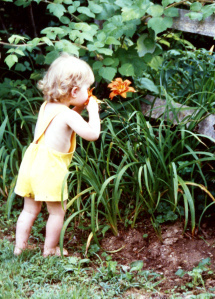 It has been many years since I made those observations. And it is not so easy to step back, let go–allow children to make their own decisions, their own mistakes, to experience their own failures and allow them space to feel their own joys.
It has been many years since I made those observations. And it is not so easy to step back, let go–allow children to make their own decisions, their own mistakes, to experience their own failures and allow them space to feel their own joys.
Raising children taught me a great deal I might never have learned otherwise. I’ve never reflected before on whether I was confident as a mother, but reading this old essay makes me believe that I was. Certainly, if Burroughs’ definition is accurate, I was “focused and comfortable with what you’re doing.” That’s how I feel when I am truly engaged with an experience–writing, teaching, gardening…
Uncertainties and failures abound. But so do successes.


July 24, 2012
Ambition & failure
Some of my non-writer friends are surprised to learn that I am in the process of trying to get a new book into print. After all, Water-Rites just came out! So shouldn’t I be concentrating on selling that book and resting on my laurels awhile? To be sure this collection is a “success” before continuing on?
Those who write poetry or literary fiction, however, recognize that by the time a book finally gets published, the work in it is “old.” We are already well into new projects, working on new ideas, using new styles to express ourselves, addressing different topics. If I were to wait to write new poetry until after my book got into print, I’d probably never write another collection. The economics of the poetry world are too close to what Lewis Hyde calls the “gift economy” to imagine we can stop writing, sell a book, live off of the income and then write another one. Even many best-selling authors cannot do that. Poets are lucky to sell 500 copies of a book. We write for other reasons. Need. Love. Ambitions of a non-monetary kind.
Like all artists, poets take risks. Sometimes the changes we make in our work are not well-received. Sometimes they aren’t any good. Failure, however, can be a most excellent instructor. Sometimes, to shake myself up when the writing seems stuck, I attempt a completely different activity. Gardening clears my mind, and gardening offers many chances to fail at what I do. I’ve also tried watercolor painting, sumi ink calligraphy, modeling clay, embroidery, dancing, piano, and many other endeavors. I cannot claim to be remotely good at any of them yet each of these pursuits has taught me much…often through my lousiness.
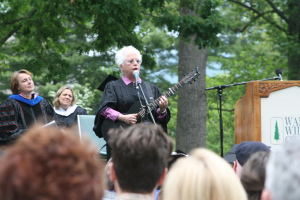
Janis Ian, 2012. Photo by David Sloan.
Recently, Janis Ian–singer, songwriter, science fiction author, and philanthropist–offered the commencement address at Warren Wilson College in Asheville, NC. In her speech, Ian talked about being self-taught; being a self-taught success. And she had important things to say about failing, as well. She said, “We are rarely asked what success really represents to us, or why failure is so demeaning.” Then, she admitted that she herself had always avoided failure but that at a point in her life when she felt unhappy with everything she was producing, “I had to learn to fail before I could find my way again.”
Her approach was to take ballet lessons! At age 33. And she was awful at it, but she enjoyed doing it. Then she attempted other things at which she was terrible, and she learned to overcome some of her fear of failing.
An autodidact myself, even though I do have academic degrees, I found I could easily relate to Ian’s experiences. The part of her speech that spoke to me most was this section:
“You see, I am an artist. I believe that art saves. I believe it is often the only thing that stands between us and chaos. I have faith that while the world is crumbling, art survives. So to feel like my work was a mockery of what I could do, that I was not living up to my talent…well, it was killing me.”
Art requires us to do our best, to be ambitious and strong, to take risks and –occasionally– to fail. To fail spectacularly perhaps, or just to produce a bunch of small, humiliating, stupid failures…like dancing badly in your own room where no one can see you.
But dancing can feel so wonderful, so freeing, so different from writing! It’s worth doing badly. Sometimes when we have less at stake, we find new methods of expression and new ways to keep our fears, including the fear of failure, at bay.
~~
The full speech is available on Warren Wilson’s site here.


July 19, 2012
Confident but not certain: the garden
Recently, I listened to a radio interview with Madeleine Albright, former Secretary of State, who is promoting her latest book. The interviewer asked her what quality she thought most crucial to a good leader. Albright has met many, many leaders; she is also a brilliant person. It was a good question to ask her, and she had an excellent and thought-provoking answer: A good leader should be confident, but not certain. (If you download the mp3 file in the link above, her explanation of this idea comes near the end of the program.) Powerful people who are both confident and certain of themselves, their aims, knowledge, and ideas, are too likely to veer into autocratic dictatorship. Those who are neither certain nor confident are too easily swayed by advisors with their own agendas or are unable to make decisive moves. A person who is open-minded–and therefore not certain–but who is confident in his or her ability to make a good decision once the facts are in, leads wisely and well even when mistakes occur due to faulty information or circumstances beyond anyone’s control.
We could all benefit from becoming more confident and less certain. It strikes me that Socrates might have possessed this pair of qualities. The philosopher continues to question and is therefore not certain; but the uncertainty isn’t of the waffling, inconclusive kind. Uncertainty in Albright’s use of the word means curious, inquisitive, searching. The confident person trusts his or her values (confidence, from fidere, “to trust”) but does not let dogma or single-perspective “certainties” obscure research, facts, other perspectives.
I will grant that this approach is difficult for us humans, and that is why so few leaders possess this pair of traits. While I have no interest in becoming a world leader, I plan to keep Albright’s phrase in mind and discover whether I can become more confident and less certain in my life.
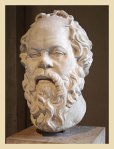
This bust resides in the Louvre, and the image was found here: http://www.humanjourney.us/greece3.html
~
Gardening is one area that relates well to confidence and uncertainty, though in a slightly different form of practice. I’ve been a gardener for over 30 years, and one thing you learn when you garden is that there are no certainties. Planning takes mental and physical effort and preparation, and then there are the endless obstacles involved in planting and overcoming soil deficiencies, insects, fungi, and weather inconsistencies just to name a few. Am I a confident gardener? Yes. Years of research, experiment, study, practice, trial and error–and successes–have made me confident. But there are always new hybrids to try, new species to plant, and there are problems that never seem to go away (why can’t I get carrots to grow here, when I have grown carrots every other place I’ve lived? How to keep certain fungi at bay using organic means?).
And one never has any sort of surety or pledge (the etymology of “certainty”) that those tomatoes will ripen without blossom end rot or fusarium wilt, that the pigweed will not take over during the gardener’s five-day vacation (well, that’s almost a certainty!), or that hail will not wreck the whole summer’s worth of plantings.
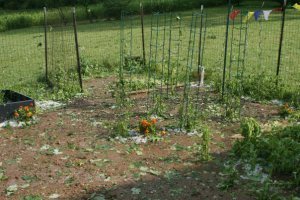
June, 2009–after the hailstorm
This year, my vegetable garden is producing well despite overbearing heat, hard brief rains, and far too many weeds. I feel annoyed with its overgrown appearance, but one thing about gardens is you get another chance as long as you can wait a couple of seasons.
Meanwhile, with a little more thought and research, I’m confident I can plan an even better garden next year.


July 17, 2012
Flame and ash
I have often imagined what it feels like to lose everything in a fire. Particularly if you are a writer or painter, and you work with easily consumable tools–paper, for example. Maxine Hong Kingston has been articulate and interesting on this situation; perhaps it was her well-reported experience that first got me thinking about how terribly affecting such a loss would be. In 1999, a friend of ours whose business is woodworking lost his shop, tools, work, and wood in a workshop fire. The shock was the worst part–like Hong Kingston, our friends had been away from home and returned to find cinders where their livelihood had been.
Last week, Michael Czarnecki, publisher and sole proprietor of FootHills Publishing, was vacationing in Maine when he learned his house and business had burned to the ground. I have heard that phrase before–but it was literally the case: to the ground. With the loss of clothing, memorabilia, musical instruments, furniture, etc. came the loss of livelihood and the loss of FootHills’ archive of 20+ years of small-press publishing. Many, many books went up in flames, a life’s work.

Paul Martin’s lovely chapbook Morning on Canal Street, FootHills Publishing.
Michael has been documenting the remains and posting images on his Facebook Page. Pictured here, what’s left of a copy of Paul Martin’s chapbook, one of the few that were still recognizable after the tragedy. Paul is a colleague of mine, and this photo makes me sad.
I am sure Michael has not yet done a full accounting of his destroyed inventory. The two books of mine he published are certainly among the casualties, and I feel a selfish pang over that. If he gets the press up and running again–and he plans to (he is an optimist and a hard worker)–he’ll probably try to reprint at least some of the 300 or so books FootHills has produced over the years. The more recent books will be easier to reprint, as he had his computer with him and it was not lost in the fire…pdf files of some of the books are intact. But the “history” of the press…its archival, early chapbooks, may be gone for good.
Once again, I reflect on ephemera. One of the most moving photos Michael took is one of his sons’ birth certificates, charred, the edges the same color as the tiny footprints that are still visible. We are so vulnerable.
And we endure, too. Our art helps us to manage these difficult passages. Love helps us navigate the ashes.
If you are interested in and financially able to help FootHills Publishing recover and rise, phoenix-like, from the ashes, you can go to the FootHills website and donate through PayPal or send a check to
FootHills Publishing
PO Box 68
Kanona, NY 14856
Thanks very much. As Michael Czarnecki says, “Never stop asking for poems.”


July 15, 2012
Poems that help us to endure
I’ve recently completed reading Eugenia Semyonovna Ginzburg’s memoir Journey into the Whirlwind. What has struck me about the memoir is, in particular, Ginzburg’s reliance on poetry as a means to enduring prison, deprivation, oppression.
In several selections, she reiterates how reciting or recalling poetry–Pushkin, Pasternak, Blok, Mandelstam, and lesser-known (to us Westerners) poets such as Tyutchev, Chorny & Nekrasov–gave her hope or encouraged her to keep on in the face of awful situations, or just to remind her that others have endured harsh and terrible conditions and found the means to express themselves despite it all.
I believe poems–and art of all varieties–help us to endure. Some poets who have helped me to endure include Anna Akhmatova, Mark Doty, Mary Oliver, Gregory Orr, John Donne, Yehudi Amichai, Stanley Kunitz, Donald Hall, Emily Dickinson, Adrienne Rich, Marie Ponsot, and others. Too many to name.
Who has helped you to endure? Whose art, whose poetry, whose stories, whose music?
When we reflect on these creations, perhaps we can learn more about ourselves.


July 5, 2012
Love is all you need?
My daughter made this collage when she was nine years old. This is a poorly PhotoShopped version (the original has faded pretty badly):
~

Love is all you need
I was listening to The Beatles recently, music that takes me pretty far back into my childhood. I’ve been thinking about musical cues to memory for another poetic project on which I am currently working, so the concept of music evoking imagery, subjects, memoir has been uppermost in my mind. More on that project perhaps later, when I have arranged my thoughts more cogently. Meanwhile, some thoughts on “All You Need is Love.” Or more correctly, some musings that begin with “All You Need Is Love.”
When I was an adolescent, that Beatles’ song seemed to signify on several levels. One level was the universal: Love as the root of human sharing, as the means to peace and understanding, as the solution to the Big Problems. Another level was the romantic: Love as the way to solve personal loneliness, finding the partner with whom I could mesh, forge a permanent and personal understanding.
Love as solution. I view that ‘philosophy’ as a non-philosophy now; it is simplistic and impossible. Love is not a solution; it is a verb, active and engaging. Love certainly does not fix things. Its necessity, however, I do not question. Not for those who wish to be fully human.
Wait, you’re going to object–love is a noun, too. In most dictionaries, love as a noun is the entry before love as a verb. Arbitrary on my part to assert precedence for the verb, but I am cautious of abstractions even though I relish philosophy. Love as noun is abstract.
Merriam-Webster: “strong affection for another arising out of kinship or personal ties.” My OED (compact, print edition) contains 9 columns defining Love as a noun and two defining Love in the verb sense.
When I say love is a verb, I mean that in definition 3b in the OED: “to entertain a strong affection; in the reciprocal sense” and 4c: “to take pleasure in the existence of (a virtue, a practice, a state of things) in oneself, in others, or in the world generally.” Love need not be reciprocal, though that feels best to us–hypersocial beings that we are (see my post on Brian Boyd). Love is the greater part of compassion, in which case love is something we do.
I know people who have chosen to take their own lives. A few felt the sense of despair that comes from feeling there is no love (and therefore, no hope). But that is not always the case; some who took their lives did feel love, knew love deeply, knew that others loved them and would miss their physical presence. Love was not all these people needed.
And love was not the solution.
I think we damage ourselves when we believe that love is the solution to our problems. We need other strategies, other fullness in our lives, the tools to overcome or bear with many obstacles; we need perspective and humor and grace. Love alone, in and of itself, doesn’t make peace break out. It does not solve all the issues in a truly profound and sharing relationship–not on its own. Love needs other actions, and other abstractions (trust, communication, compassion, patience…) to do its work. It does not solo well–that is not what love needs. Altruism cannot exist in a vacuum, nor can romance, nor compassion.
It takes some effort not to become sentimental here (but Bachelard defends a certain amount of sentiment…)
This is not my definitive post on the subject of love! I need to read more philosophers on love, and to consider love’s evolutionary role, and its spiritual role, in human existence. I’ve done reading on t his in the past, but it was all very long ago. Now might be a good time to begin anew (since “I was so much older then, I’m younger than that now”).








June 30, 2012
Berries
My region, like many others, has been sweltering through a heat wave lately. The mild winter pushed bloom times and fruiting times a bit earlier than usual; blackberries started ripening ten days ago, and now we have blueberries before July.
But not much before July. In celebration of blueberries and other joys of summertime, here’s a poem from my collection Small Things Rise & Go.
The Blue of July
We pick the first blueberries
while lilies gape at us,
peering over their green fans.
Birds’ tirades scatter over wind
and into our ears,
buffeting us with scold and caw and
something not melody but song:
a song of fruit, of seeds and
mealybugs and inchworms,
the wild clack of bamboo
or maple branches.
Summer’s like a mulberry,
a blueberry, dark and vivid.
It stains the day sweaty,
leaves bright pollen on our noses
as we inhale the sun
on lilies, as white clover gathers
like clouds upon the grass
and, sweet in our mouths,
the day explodes—blue.
~
A note to anyone who has ordered or wishes to order Water-Rites: The order has gone to the printer. Possibly 2-3 weeks before my book is in your hands. Many thanks.








June 25, 2012
Control
Human beings crave control. We want to be the masters of our own fate or to believe that there is a master of our fates who can be entreated or persuaded, propitiated or cajoled into helping us to gain control of our lives or the lives of others. We want to change the weather so that the rain falls when the soil needs rain, wetting the seeds we’ve sown, and so that the warmth comes when our plants need warmth. We want the sea to be calm and the fog to lift when we are ready to set sail. We want fine, sunny days when we visit the beach to swim or head out for a picnic. We want just enough snow so that school’s canceled, but not so much that our power goes out. We pray. We dance. We chant. We invent little private rituals and participate in community rituals.
We want to control our health. It does not seem to be an unreasonable aim. We want to control our relationships–just enough to keep ourselves happy. We want control over our careers and our income–not so much to ask. We want to be able to make our own decisions. We want choices so that we feel we have control over our lives.
My gardens are my analogy today. I’m still endeavoring to exert some control over my vegetable garden, but I kept my purposes modest this year; I planted fewer beans, fewer tomatoes, fewer peppers, fewer potatoes, no onions, no peas, no edamame, no radishes…the walk-through rows are wider so it is easier to weed. Beginning with the dry warm winter and some assemblies of challenges that do not pertain to the garden, the season looked “iffy.” Then came lashings of showers in May. A challenging season, but not insurmountable. I have been gardening a long time, and I have methods of adapting to things I cannot control. It comes with the territory.
The ornamental beds have presented the most difficult struggle with my need to control the space I (somewhat ridiculously) consider my own. When the beds get overgrown–as they are now–I know that I can accept their exuberant rioting with the successful weeds. I can say, “This is what nature intends. There is beauty here.”
I do know that. But the controlling mind–the monkey mind–says, “Too much penstemon; it’s gotten aggressive. Deadhead the peonies. Pull up the plantian, the wild asters, fleabane, wild garlic, crabgrass, bermuda grass, creeping charlie, five-leaf vine. Get the seedlings out of there (mulberry, redbud, oak). Mulch. Keep the rabbits off the hostas. Move the marybells. Get the weeds out of the alchemilla…”
My head clouds with fog. The seas get rough and I despair, because I cannot control things. Not even a small garden.
Instead, I could be meditating on green. On the amazing variety of leaf-shapes, on dappledness (like G. M. Hopkins):
Pied Beauty
Glory be to God for dappled things—
For skies of couple-colour as a brinded cow;
For rose-moles all in stipple upon trout that swim;
Fresh-firecoal chestnut-falls; finches’ wings;
Landscape plotted and pieced—fold, fallow, and plough;
And áll trades, their gear and tackle and trim.
All things counter, original, spáre, strange;
Whatever is fickle, frecklèd (who knows how?)
With swíft, slów; sweet, sóur; adázzle, dím;
He fathers-forth whose beauty is pást change:
Práise hím.
~
Here is one aspect of my ornamental garden. Overgrown, yes. Lush, diverse, lovely in its unrefined way. Until I have the wherewithal to tear through and divide and move and mulch, this is not a bad view, the definition of … lack of restraint, ornamentals gone wild. Freedom, I suppose.
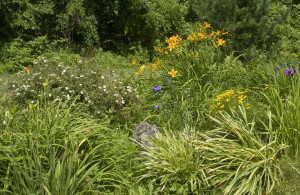
A little too much of some good things.
As we grow, we learn to let go. So I am told. Garden, you have a chance to go wild!
And I guess I have the opportunity to learn to live with that.











